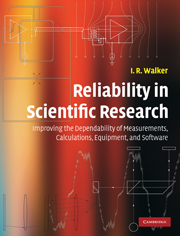 Reliability in Scientific Research
Reliability in Scientific Research Published online by Cambridge University Press: 05 June 2012
Introduction
In certain types of optical measurements, such as those making use of interference, the most elusive sources of reliability difficulties are structural vibrations, acoustic disturbances, and temperature variations in the optical path. The first two phenomena are often a problem in many types of sensitive measurement in research, and these issues are discussed in detail in Section 3.5.3. Temperature effects are examined in the following section.
Precision positioning devices in optical systems can cause difficulties due to mechanical instabilities and other problems. These are discussed in Section 8.2.3.
The most general problem in optical work – affecting all apparatus to a greater or lesser degree – is contamination of optical surfaces. At one end of the scale, the problem may be merely scattering of light by dust (a serious issue in the case of, for example, diffraction gratings), which can often be solved by protecting and/or cleaning the surfaces using elementary methods. At the other extreme, when high-powered lasers are involved, contamination of optical surfaces may result in damage, or even destruction, of optical components. The process of cleaning optical surfaces may itself be difficult, depending on the character of the devices involved and the nature of the contaminants. If done frequently, cleaning can easily be more detrimental to the performance of the optics than the presence of contamination. These issues are discussed in more detail in Section 10.6.
To save this book to your Kindle, first ensure [email protected] is added to your Approved Personal Document E-mail List under your Personal Document Settings on the Manage Your Content and Devices page of your Amazon account. Then enter the ‘name’ part of your Kindle email address below. Find out more about saving to your Kindle.
Note you can select to save to either the @free.kindle.com or @kindle.com variations. ‘@free.kindle.com’ emails are free but can only be saved to your device when it is connected to wi-fi. ‘@kindle.com’ emails can be delivered even when you are not connected to wi-fi, but note that service fees apply.
Find out more about the Kindle Personal Document Service.
To save content items to your account, please confirm that you agree to abide by our usage policies. If this is the first time you use this feature, you will be asked to authorise Cambridge Core to connect with your account. Find out more about saving content to Dropbox.
To save content items to your account, please confirm that you agree to abide by our usage policies. If this is the first time you use this feature, you will be asked to authorise Cambridge Core to connect with your account. Find out more about saving content to Google Drive.